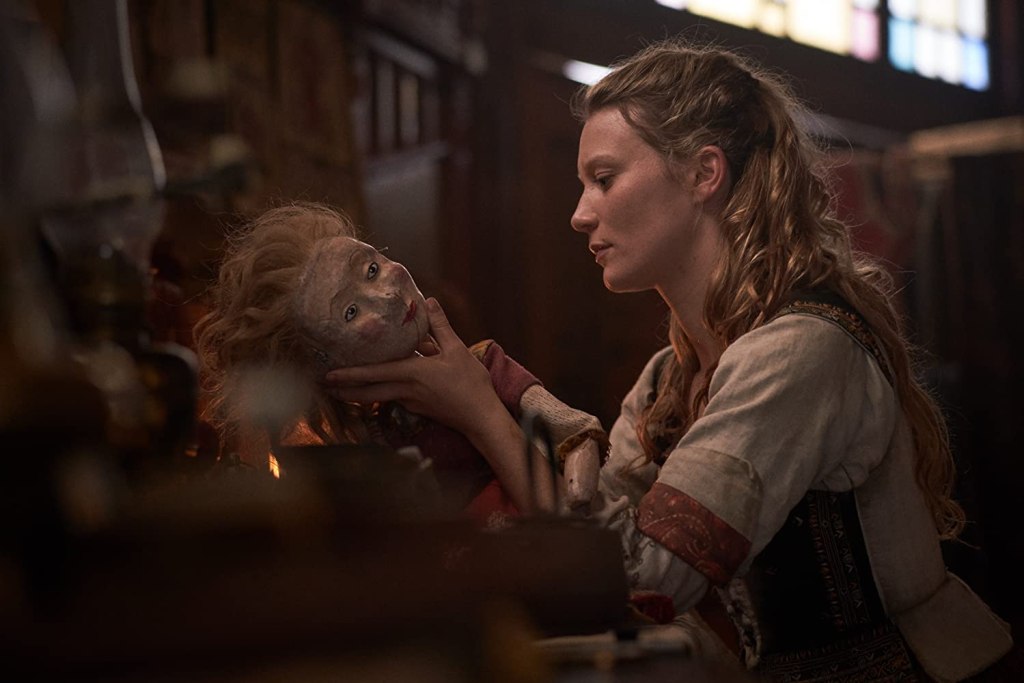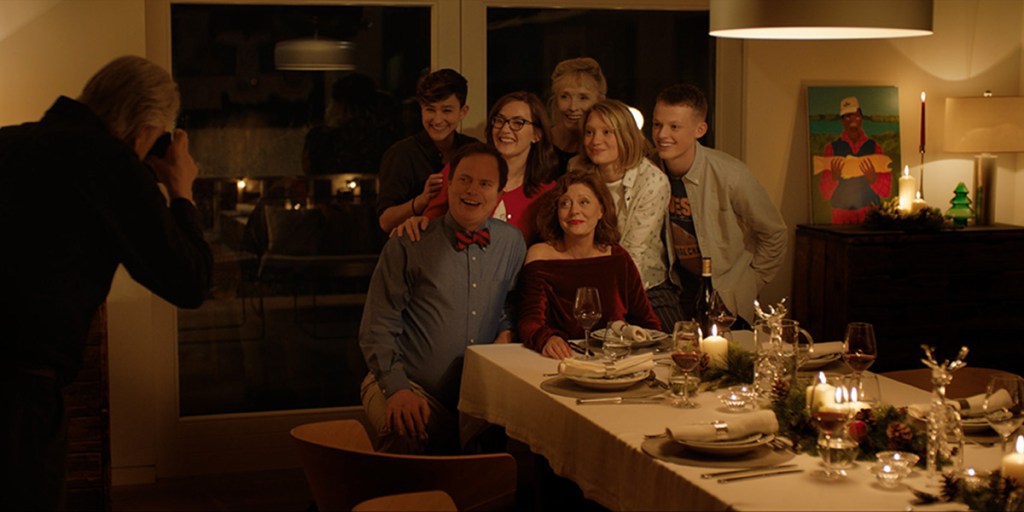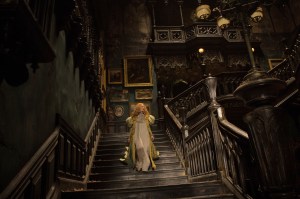God may take smoke breaks but the devil sure doesn’t. Little Arvin Russell (Michael Banks Repeta) is a boy living with his parents in Knockemstiff, Ohio in the 1950s – about as rural as it gets, a place where everyone is someone else’s relation but alarmingly that doesn’t seem to stop them from coupling up. The Russells mostly keep to themselves. Mom Charlotte (Haley Bennett) was a waitress when she caught Willard’s eye. Willard (Bill Skarsgård) has recently returned from war, and when the urge to pray hits, he takes it seriously, building a “prayer log” in the backyard where he often drags son Arvin and compels him not only to pray, but to pray well, which means fervently, and loudly. Their prayers don’t work. Charlotte dies. Willard soon follows. A local police officer (Sebastian Stan) comforts Arvin and makes sure he gets to his grandmother over in equally rural West Virginia. There he grows up with a stepsister, Lenora, who hadn’t been orphaned so much as abandoned by mom Helen (Mia Wasikowska) and dad Roy (Harry Melling). Eventually Arvin (now played by Tom Holland) and Lenora (Eliza Scanlen) grow up, and though Arvin remains a humble and peaceable young man, a solar system worth of sinister characters is orbiting him, and he’s on a collision course with all of them.

This film has a deep cast. I haven’t yet mentioned Robert Pattinson, Riley Keough, or Jason Clarke, some of whom don’t appear until 45 minutes or more into the film, but all them are leaving quite an impression. Holland is the real stand-out though, and well he should be, since he is the sun and the others are mere planets. Nearly all of them have two things in common: religion, and violence. There will be lots of both.
It helps to remember that the title is The Devil All The Time. Not part time. Not even full time. ALL OF THE TIME. He’s relentless. Arvin, though, doesn’t care much for religion. He’s had a bad experience with it, and you can hardly blame him. So he’s establishing his morality based on other concepts, on his own internal sense of right and wrong, one that snakes in and out of every last one of these characters, and eventually it leads him back to the town where he was born, and to the officer who once led him away from a crime scene. No matter how far you go, you always end up right back where you started.

Director Antonio Campos indulges his cast, giving them ample time and space to breathe within scenes, and who can blame him when everyone is doing such excellent, and often against-type work. The movie is bleak, and violent. It is most definitely not an action movie. The violence isn’t stylized, it isn’t fun, it isn’t entertaining. It makes you cringe, and coupled with religion, makes you think.
The film is gritty, atmospheric, its inky fingers slowly unfurling themselves, choking the characters on their own nefarious intentions, sending tendrils of shiver down your spine as the tension increases. It is not a perfect film, nor an even one. The tone suffers, and just plain cannot be sustained during the film’s bloated run-time. But I enjoyed it, overall, enjoyed the riveting performances and the interesting take on narration, performed by the book’s author, Donald Ray Pollock. It’s got some disturbing imagery and some graphic violence too, but when the film is over, it’s the issues you’ll still be thinking about, trying to tease out what it all means.



 people so fond of social gang-bangs. Sam, who very much looks the part of a gentleman, and who has arrived with “the Farrah Fawcett of miniature horses”, a lovely girl named Butterscotch, traipses through town in search of the forever-inebriated parson, whom he has engaged and will pay generously for his services. He’s here to marry his “true pure love” Penelope (Mia Wasikowska), and they’ve only got to battle the wilderness, stave off predators, rescue her from “scum-loving evil” and survive anything from an interrupted morning wank to a bent-gun fight in order to make his intended his wife.
people so fond of social gang-bangs. Sam, who very much looks the part of a gentleman, and who has arrived with “the Farrah Fawcett of miniature horses”, a lovely girl named Butterscotch, traipses through town in search of the forever-inebriated parson, whom he has engaged and will pay generously for his services. He’s here to marry his “true pure love” Penelope (Mia Wasikowska), and they’ve only got to battle the wilderness, stave off predators, rescue her from “scum-loving evil” and survive anything from an interrupted morning wank to a bent-gun fight in order to make his intended his wife. because she spurns the favour of her childhood friend, a mild-mannered, handome doctor who cares for her (Charlie Hunnam) in favour of the mysterious badboy newcomer (Tom Hiddleston). Even the brutal murder of her beloved father doesn’t stop her from flitting off to England to a crumbling old mansion atop a mountain that oozes blood-red clay with new hubby Thomas (Hiddleston) and his wicked sister Lucille (Jessica Chastain) as her only (living) roommates.
because she spurns the favour of her childhood friend, a mild-mannered, handome doctor who cares for her (Charlie Hunnam) in favour of the mysterious badboy newcomer (Tom Hiddleston). Even the brutal murder of her beloved father doesn’t stop her from flitting off to England to a crumbling old mansion atop a mountain that oozes blood-red clay with new hubby Thomas (Hiddleston) and his wicked sister Lucille (Jessica Chastain) as her only (living) roommates. made more moody, more dramatic. Weeks and weeks were spent stitching an intricate detail onto one of Chastain’s dresses that gets a lot of screen time. And this being a haunting ghost story, every costume had to look just as meticulous from behind, for those eerie shots down darkened hallways.
made more moody, more dramatic. Weeks and weeks were spent stitching an intricate detail onto one of Chastain’s dresses that gets a lot of screen time. And this being a haunting ghost story, every costume had to look just as meticulous from behind, for those eerie shots down darkened hallways. starting up yet another business (landscape design) and Nic is barely tolerating the effort. But Paul’s arrival is completely destabilizing. Not only is their daughter moving away, they also feel like they’re losing their kids to a new, cool parent who has never had to discipline them or hurt their feelings. When Jules goes to work for Paul, it’s kind of the last straw. No wait: when Jules sleeps with Paul, that’s the very last straw.
starting up yet another business (landscape design) and Nic is barely tolerating the effort. But Paul’s arrival is completely destabilizing. Not only is their daughter moving away, they also feel like they’re losing their kids to a new, cool parent who has never had to discipline them or hurt their feelings. When Jules goes to work for Paul, it’s kind of the last straw. No wait: when Jules sleeps with Paul, that’s the very last straw.